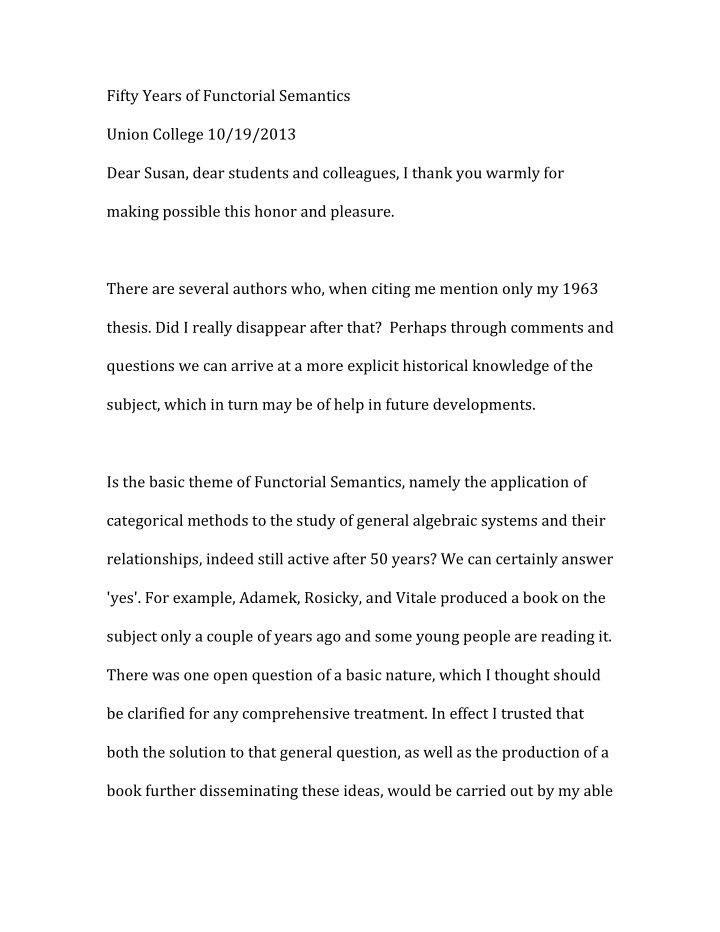



Fifty ¡Years ¡of ¡Functorial ¡Semantics ¡ ¡ ¡ Union ¡College ¡10/19/2013 ¡ Dear ¡Susan, ¡dear ¡students ¡and ¡colleagues, ¡I ¡thank ¡you ¡warmly ¡for ¡ making ¡possible ¡this ¡honor ¡and ¡pleasure. ¡ ¡ There ¡are ¡several ¡authors ¡who, ¡when ¡citing ¡me ¡mention ¡only ¡my ¡1963 ¡ thesis. ¡Did ¡I ¡really ¡disappear ¡after ¡that? ¡ ¡Perhaps ¡through ¡comments ¡and ¡ questions ¡we ¡can ¡arrive ¡at ¡a ¡more ¡explicit ¡historical ¡knowledge ¡of ¡the ¡ subject, ¡which ¡in ¡turn ¡may ¡be ¡of ¡help ¡in ¡future ¡developments. ¡ ¡ Is ¡the ¡basic ¡theme ¡of ¡Functorial ¡Semantics, ¡namely ¡the ¡application ¡of ¡ categorical ¡methods ¡to ¡the ¡study ¡of ¡general ¡algebraic ¡systems ¡and ¡their ¡ relationships, ¡indeed ¡still ¡active ¡after ¡50 ¡years? ¡We ¡can ¡certainly ¡answer ¡ 'yes'. ¡For ¡example, ¡Adamek, ¡Rosicky, ¡and ¡Vitale ¡produced ¡a ¡book ¡on ¡the ¡ subject ¡only ¡a ¡couple ¡of ¡years ¡ago ¡and ¡some ¡young ¡people ¡are ¡reading ¡it. ¡ There ¡was ¡one ¡open ¡question ¡of ¡a ¡basic ¡nature, ¡which ¡I ¡thought ¡should ¡ be ¡clarified ¡for ¡any ¡comprehensive ¡treatment. ¡In ¡effect ¡I ¡trusted ¡that ¡ both ¡the ¡solution ¡to ¡that ¡general ¡question, ¡as ¡well ¡as ¡the ¡production ¡of ¡a ¡ book ¡further ¡disseminating ¡these ¡ideas, ¡would ¡be ¡carried ¡out ¡by ¡my ¡able ¡
colleagues ¡who ¡were ¡already ¡contributing ¡substantially ¡to ¡the ¡subject. ¡ This ¡trust ¡turned ¡out ¡to ¡be ¡well ¡justified. ¡ ¡ Let ¡me ¡recall ¡what ¡that ¡general ¡question ¡was: ¡It ¡could ¡be ¡succinctly ¡ described ¡as ¡finding ¡a ¡presentation ¡of ¡the ¡dual ¡doctrine ¡to ¡the ¡doctrine ¡ of ¡finite ¡products. ¡Here ¡I ¡use ¡the ¡term ¡'doctrine', ¡due ¡to ¡Jon ¡Beck, ¡ signifying ¡'something ¡like ¡a ¡theory, ¡but ¡higher'. ¡One ¡interpretation ¡of ¡ 'higher' ¡was ¡to ¡treat ¡the ¡logic ¡of ¡(a) ¡higher ¡types, ¡but ¡(b) ¡not ¡simply ¡in ¡ terms ¡of ¡predicates ¡on ¡them, ¡using ¡instead ¡a ¡fibrational ¡model ¡of ¡actual ¡ proofs, ¡as ¡opposed ¡to ¡the ¡mere ¡existence ¡of ¡proofs; ¡these ¡conceptions ¡ were ¡embodied ¡in ¡my ¡1968 ¡notion ¡of ¡Hyperdoctrine ¡(AMS), ¡which ¡has ¡ figured ¡in ¡some ¡later ¡work, ¡for ¡example ¡in ¡Bart ¡Jacobs' ¡thesis ¡(1990), ¡on ¡ comprehension ¡categories. ¡ ¡ ¡ However, ¡in ¡the ¡present ¡connection, ¡I ¡am ¡referring ¡to ¡doctrines ¡in ¡the ¡ sense ¡of ¡'theories ¡whose ¡models ¡are ¡theories', ¡and ¡much ¡more ¡ specifically ¡to ¡2-‑monads ¡on ¡the ¡category ¡of ¡categories; ¡these ¡are ¡ referred ¡to ¡as ¡'equational ¡doctrines' ¡in ¡Springer ¡Lecture ¡Notes ¡80, ¡ (1969). ¡ ¡Let ¡us ¡concentrate ¡on ¡those ¡equational ¡doctrines ¡for ¡which ¡the ¡ category ¡S ¡of ¡small ¡sets ¡is ¡an ¡algebra. ¡In ¡particular, ¡the ¡doctrine ¡D ¡whose ¡
algebras ¡are ¡categories ¡with ¡finite ¡products ¡is ¡appropriate ¡to ¡the ¡(many-‑ sorted) ¡theories ¡of ¡general ¡algebraic ¡systems ¡in ¡the ¡traditional ¡sense. ¡ ¡ ¡Because ¡there ¡are ¡2-‑dimensional ¡versions ¡of ¡enrichment, ¡and ¡ ¡ commutativity, ¡et ¡cetera, ¡we ¡can ¡rather ¡freely ¡make ¡use ¡in ¡the ¡category ¡ of ¡categories ¡of ¡the ¡hom-‑tensor ¡operations ¡on ¡bimodules ¡coming ¡from ¡ Cartan-‑Eilenberg ¡1956. ¡For ¡example, ¡the ¡dual ¡doctrine ¡of ¡any ¡equational ¡ doctrine ¡D ¡is ¡the ¡one ¡whose ¡value ¡at ¡any ¡category ¡C ¡is ¡ ¡ ¡ ¡ ¡ D* ¡(C) ¡ ¡= ¡ ¡D-‑Hom(S^C,S). ¡ This ¡is ¡clearly ¡the ¡'algebraic ¡structure' ¡of ¡all ¡D-‑algebraic ¡categories ¡D-‑ Hom(A,S) ¡as ¡A ¡ranges ¡over ¡the ¡category ¡of ¡algebraic ¡theories ¡(= ¡the ¡2-‑ category ¡of ¡D-‑algebras). ¡ ¡ ¡ In ¡other ¡words, ¡the ¡standard ¡lifting ¡describes ¡the ¡maximum ¡structure ¡ that ¡all ¡algebraic ¡categories ¡have, ¡insofar ¡as ¡structure ¡is ¡to ¡be ¡described ¡ by ¡the ¡meta-‑doctrine ¡of ¡equational ¡doctrines; ¡an ¡algebraic ¡category ¡is ¡ always ¡more ¡than ¡a ¡mere ¡category, ¡because ¡of ¡the ¡way ¡it ¡arises; ¡indeed ¡ it ¡is ¡a ¡D* ¡algebra, ¡so ¡that ¡if ¡we ¡wish ¡to ¡represent ¡or ¡approximate ¡some ¡ given ¡category ¡by ¡algebraic ¡categories, ¡a ¡first ¡step ¡would ¡be ¡to ¡verify ¡ that ¡it ¡be ¡a ¡D* ¡algebra. ¡That ¡may ¡not ¡be ¡sufficient ¡because ¡properties ¡in ¡ a ¡still ¡stronger ¡logic ¡may ¡need ¡to ¡be ¡invoked; ¡on ¡the ¡other ¡hand, ¡
categorical ¡equivalence ¡('recovery' ¡or ¡'descent') ¡is ¡not ¡the ¡only ¡goal ¡of ¡ such ¡investigations, ¡because ¡incomplete ¡invariants ¡are ¡often ¡the ¡tool ¡of ¡ choice, ¡as ¡for ¡example ¡in ¡algebraic ¡topology. ¡The ¡dual ¡doctrine ¡D* ¡is ¡a ¡ very ¡definite ¡thing, ¡but ¡to ¡work ¡with ¡it, ¡a ¡presentation ¡is ¡helpful: ¡ obviously ¡small ¡limits, ¡small ¡filtered ¡colimits, ¡and ¡(thanks ¡to ¡Fred ¡ Linton) ¡reflexive ¡coequalizers ¡are ¡ingredients ¡of ¡the ¡D*; ¡moreover, ¡these ¡ commute ¡and ¡distribute ¡with ¡each ¡other ¡in ¡fairly ¡obvious ¡ways. ¡But ¡are ¡ these ¡ingredients ¡sufficient ¡and ¡do ¡these ¡relations ¡generate ¡all ¡the ¡ relations; ¡in ¡other ¡words, ¡does ¡this ¡constitute ¡a ¡presentation ¡of ¡D*? ¡The ¡ answer ¡took ¡a ¡while, ¡Linton ¡being ¡followed ¡several ¡years ¡later ¡by ¡ Pedicchio ¡and ¡Wood, ¡whose ¡results ¡are ¡described, ¡together ¡with ¡much ¡ more, ¡in ¡the ¡book ¡by ¡Adamek, ¡Rosicky, ¡& ¡Vitale. ¡ ¡ ¡ The ¡use ¡of ¡2-‑monads ¡above ¡is ¡of ¡course ¡an ¡extension ¡of ¡the ¡version ¡of ¡ algebraic ¡semantics ¡and ¡algebraic ¡structure ¡discovered ¡by ¡Beck, ¡by ¡ combining ¡the ¡notion ¡of ¡algebraic ¡theory, ¡as ¡extended ¡by ¡Linton, ¡with ¡ the ¡Eilenberg-‑Moore ¡theory ¡of ¡triples ¡(later ¡called ¡monads). ¡In ¡the ¡case ¡ where ¡adjoints ¡exist, ¡the ¡structure ¡in ¡monad ¡form ¡is ¡obtained ¡by ¡simply ¡ composing ¡a ¡given ¡functor ¡with ¡its ¡adjoint. ¡But ¡note ¡that ¡the ¡case ¡above ¡ is ¡also ¡very ¡special ¡in ¡that ¡the ¡functor ¡whose ¡structure ¡is ¡being ¡extracted ¡
Recommend
More recommend